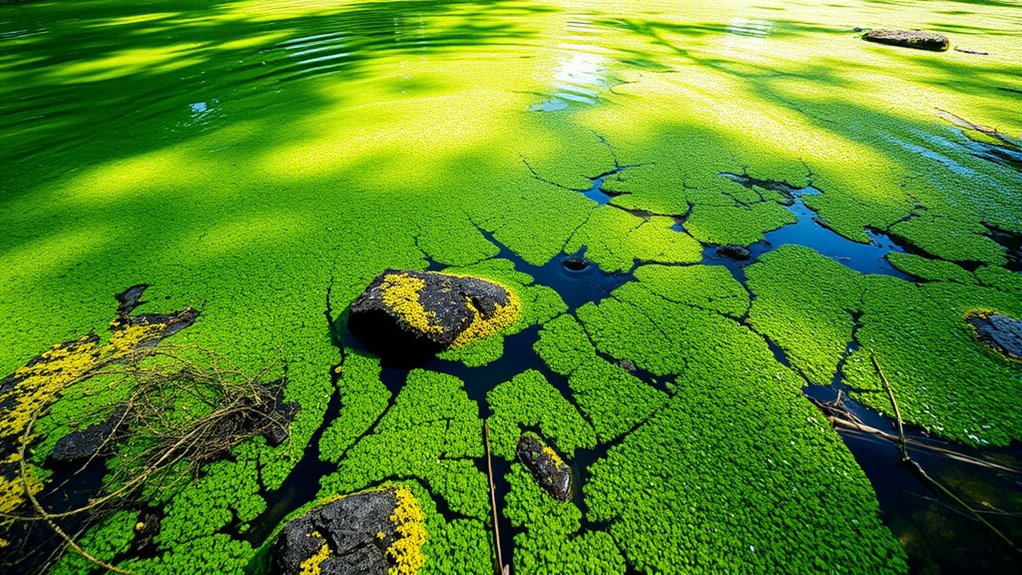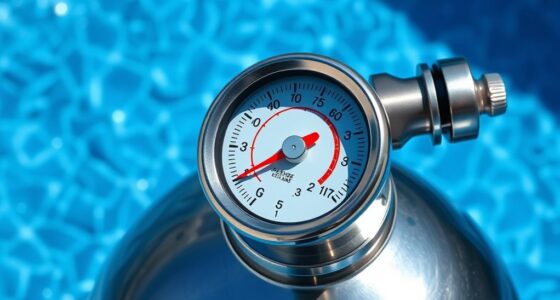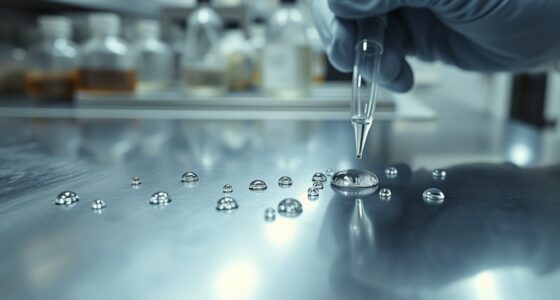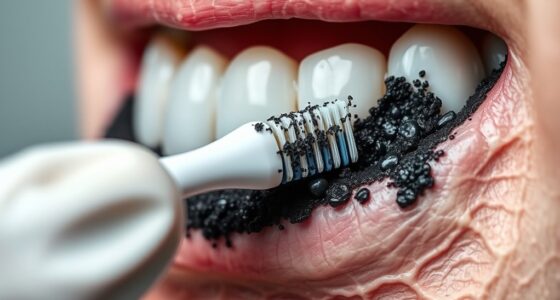To effectively treat green, yellow, and black algae, first identify the type of algae in your pond. Use natural methods like adding beneficial plants and controlling sunlight to prevent algae growth. For stubborn algae, apply targeted chemical treatments, following instructions carefully to avoid harming aquatic life. Regular water testing and maintaining proper circulation help keep algae at bay. If algae persists or worsens, professional help can guarantee safe and thorough removal. Keep exploring for more expert tips.
Key Takeaways
- Properly identify algae types to select targeted and effective treatment methods.
- Use biological controls like aquatic plants to absorb excess nutrients fueling algae growth.
- Apply appropriate chemical algaecides carefully, following label instructions to prevent harm to pond life.
- Maintain water quality through regular testing, aeration, and debris removal to prevent algae proliferation.
- Seek professional help for persistent or severe algae issues to ensure comprehensive and safe pond management.
Identifying Different Types of Pond Algae
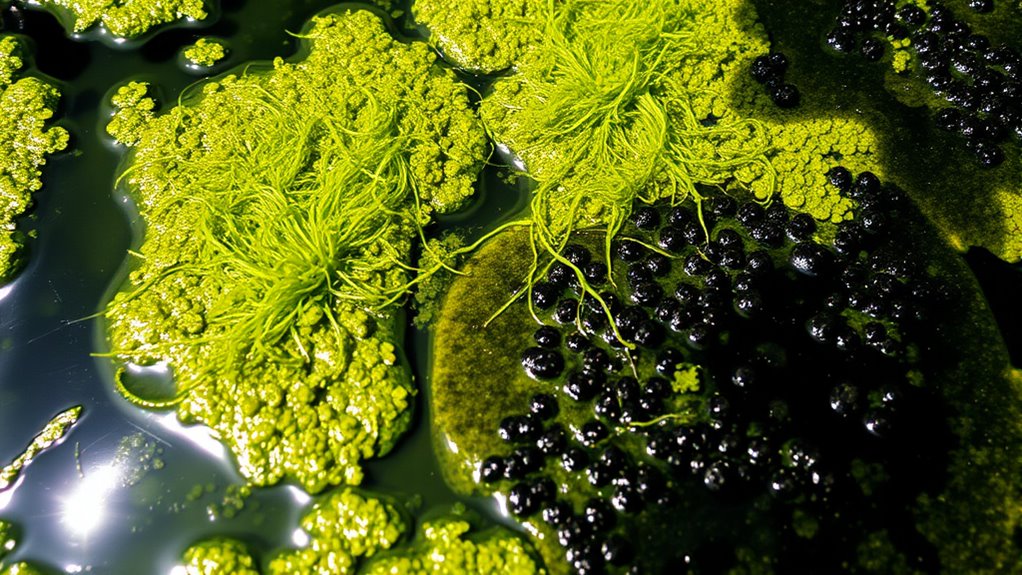
How can you tell different types of pond algae apart? First, observe their color and texture. Green algae often form slimy, filamentous layers or fuzzy mats, giving your pond a vibrant, bright green appearance. Yellow or golden algae, sometimes called diatoms, create a slimy, yellowish film that feels greasy to the touch. Black algae look like dark, slimy patches that may appear almost black or dark green, often sticking stubbornly to pond surfaces. The shape also matters; filamentous algae resemble tangled threads, while plate-like algae form slimy sheets. Recognizing these differences helps you identify which algae is thriving in your pond, so you can choose the most effective treatment approach. Proper identification is essential because different algae types require different treatment methods to effectively manage growth.
Natural Methods to Combat Green Algae

To naturally control green algae in your pond, you can introduce beneficial aquatic plants that compete with algae for nutrients and sunlight. Plants like water lettuce, water hyacinth, and duckweed absorb excess nutrients, reducing algae growth. These plants also provide shade, limiting light penetration that algae need to thrive. Regularly trimming and removing dead plant material prevents nutrient buildup. Ensuring proper circulation with a pond aerator helps distribute oxygen and discourages algae from settling. Additionally, adding submerged plants such as hornwort or Anacharis helps stabilize nutrient levels and improves water clarity. Creating a balanced ecosystem with healthy plant life is essential for maintaining pond health; healthy aquatic plants play a crucial role in this process. By fostering a balanced ecosystem with healthy plant life, you create an environment less hospitable to green algae, keeping your pond clearer and healthier naturally.
Chemical Treatments for Yellow Algae
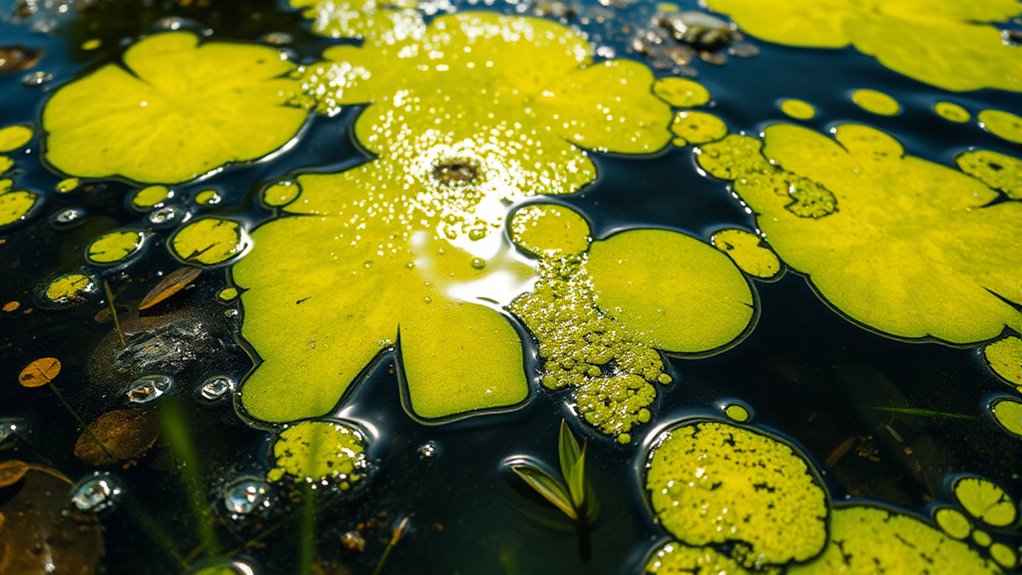
Are chemical treatments effective in controlling yellow algae in ponds? Yes, they can be, but they require proper application. Use algaecides containing copper sulfate or other approved chemicals designed for pond use. Always follow label instructions to avoid harming aquatic life. Timing is vital; treat during early growth stages for best results. Be aware that overuse can lead to algae resistance or water quality issues. To help you choose, here’s a quick comparison:
| Chemical Type | Pros | Cons |
|---|---|---|
| Copper Sulfate | Fast-acting, effective | Toxic to fish if overused |
| Quaternary Ammonium | Safe for pond plants | Less effective on mature algae |
| Hydrogen Peroxide | Breaks down quickly, safe | Needs frequent application |
Use these treatments carefully, and always monitor pond health afterward. Proper application techniques ensure safer and more effective results.
Managing Black Algae Growth Effectively
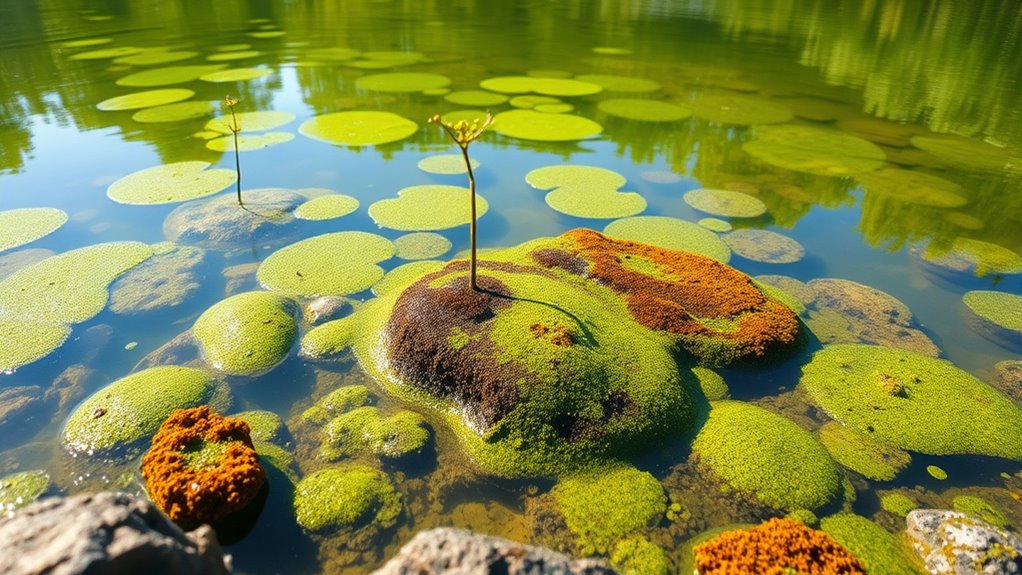
Black algae can be tricky to manage, but recognizing it early is key. You should focus on effective cleaning techniques to remove it thoroughly and prevent its return. Regular maintenance and proper water care will keep black algae from taking over your space. Incorporating preventative measures like water treatment can also help control algae growth more effectively.
Identifying Black Algae
Have you ever noticed dark, slimy patches forming on your pond’s surfaces or swimming pool walls? That’s likely black algae, a persistent and resilient type. It appears as glossy, black or dark green spots that cling tightly to surfaces. Unlike green algae, it doesn’t brush off easily and often feels slimy to the touch. Spotting black algae early is vital—it can quickly spread and damage your pond’s ecosystem. Here’s a quick comparison:
| Feature | Black Algae |
|---|---|
| Appearance | Glossy black/dark green patches |
| Texture | Slimy, tough to remove |
| Spread Rate | Rapid if untreated |
| Removal Difficulty | Requires targeted cleaning |
Identifying black algae early helps you act fast and prevent long-term damage. Additionally, understanding the types of algae can help you choose the most effective treatment methods.
Effective Cleaning Techniques
To effectively manage black algae growth, you need to employ targeted cleaning techniques that break through its tough, slimy surface. Start by scrubbing the affected area with a stiff brush to loosen algae. Use a chlorine-based or algae-specific cleaner to disinfect and kill remaining spores. Rinse thoroughly with a high-pressure hose to remove debris and residue. For persistent growth, consider applying a diluted bleach solution, but avoid overuse to prevent damage. Remember these key points:
- Wear protective gloves and goggles
- Allow the cleaning agent to sit for 10-15 minutes
- Focus on cracks and crevices where algae hide
- Rinse thoroughly to prevent residue buildup
- Repeat cleaning as needed for stubborn spots
- Proper filtration system maintenance enhances algae prevention and overall pool water quality.
Consistent, targeted cleaning keeps algae from returning and protects your surfaces.
Preventative Maintenance Tips
Implementing regular maintenance routines is essential for preventing black algae from taking hold. You should routinely check your pool’s water chemistry, keeping pH levels between 7.2 and 7.6, and maintaining proper chlorine levels. Regularly brushing pool walls and tiles helps remove algae spores before they can establish themselves. Keep your filtration system clean and functioning efficiently to prevent algae buildup. Shock the pool periodically, especially after heavy use or rain, to kill any lingering spores. Also, guarantee proper circulation everywhere in the pool to prevent stagnant areas where algae thrive. Cover the pool when not in use to reduce debris and limit algae growth. Maintaining optimal water chemistry can also support overall algae prevention and keep your pool in top condition. Consistent maintenance disrupts black algae’s ability to establish itself, saving you time and effort in the long run.
Preventative Strategies to Keep Algae at Bay
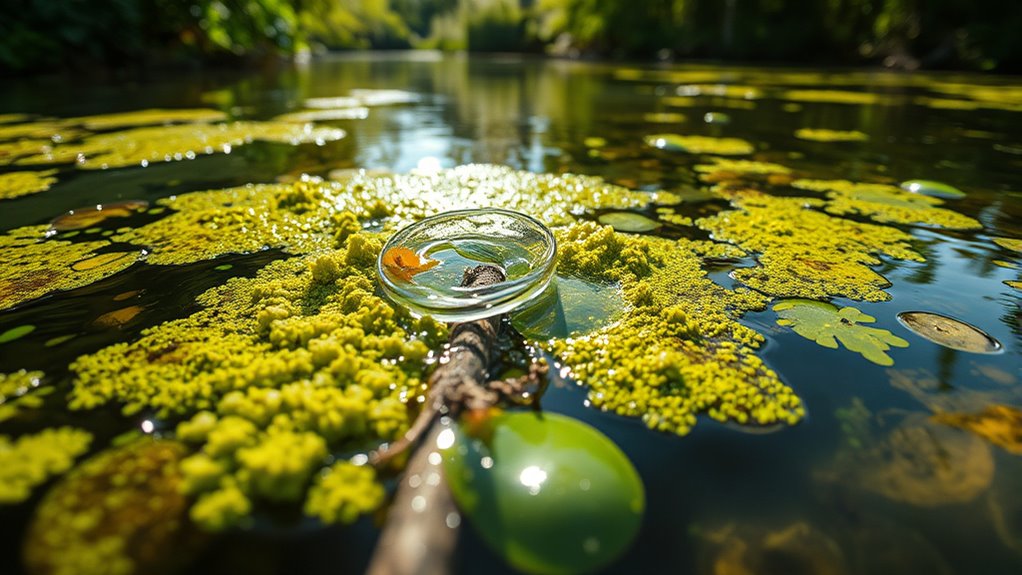
Preventing algae growth starts with maintaining proper water management and environmental conditions. You should control nutrient levels, especially phosphates and nitrates, which algae thrive on. Regularly removing debris and excess organic matter reduces food sources for algae. Limiting sunlight exposure prevents photosynthesis, so consider shading or using pond covers. Installing a good filtration system keeps water circulating and minimizes stagnation. Also, monitor water pH to keep it within a healthy range for aquatic life and algae prevention. Incorporating regular testing of water parameters helps detect potential issues early and maintain optimal conditions for your pond or water feature.
Maintain water quality by controlling nutrients, reducing debris, limiting sunlight, and ensuring proper filtration.
Remember these key strategies:
- Limit nutrient buildup
- Reduce sunlight exposure
- Keep water moving with proper filtration
- Remove debris promptly
- Monitor and adjust pH regularly
Maintaining Water Quality and Circulation

To keep your water clear and healthy, you need to monitor its quality regularly. Proper filtration setups help maintain consistent circulation and remove debris that can fuel algae growth. By testing your water frequently and ensuring your filtration is working correctly, you set a solid foundation for algae prevention. Utilizing total‑cost clarity in your filtration choices can help you select systems that are both effective and affordable over time.
Regular Water Testing
How often do you check your water quality to guarantee ideal algae treatment? Regular testing is essential to catch issues early and maintain a healthy environment. By monitoring key parameters, you can prevent algae blooms before they become a problem. Focus on these factors:
- pH levels, keeping them between 6.5 and 7.5
- Ammonia and nitrite levels, ensuring they’re at zero
- Nitrate concentrations, keeping them low
- Dissolved oxygen, maintaining adequate levels
- Temperature, keeping it stable within the recommended range
Consistent testing helps you identify imbalances quickly, allowing timely adjustments. Use reliable test kits and record results to spot trends. Regular water testing can also help detect automated monitoring systems that improve efficiency and accuracy. Prioritizing regular water checks keeps algae at bay and promotes a vibrant, balanced aquatic ecosystem.
Proper Filtration Setup
A well-designed filtration setup is essential for maintaining water quality and ensuring proper circulation in your aquatic environment. It helps remove debris, excess nutrients, and harmful toxins that can fuel algae growth. Choose a filter with adequate capacity for your tank size, and guarantee it includes mechanical, biological, and chemical filtration. Mechanical filters trap particles, biological filters support beneficial bacteria that break down waste, and chemical filters remove dissolved impurities. Proper placement is key—position the filter to promote even water flow without creating strong currents that stress aquatic life. Regular maintenance, like cleaning or replacing filter media, keeps the system running efficiently. A reliable filtration setup creates a healthy environment, prevents algae blooms, and keeps your tank crystal clear.
When to Seek Professional Assistance

If algae overgrowth becomes persistent or difficult to control, it’s time to bring in a professional. You might notice algae quickly returning despite your best efforts, or if your attempts cause water quality issues. A professional can diagnose underlying problems and recommend targeted solutions. Consider seeking expert help if:
- Algae covers more than 50% of your pond’s surface
- Water becomes murky, foul-smelling, or unsafe
- You’ve tried multiple treatments without success
- Your pond’s ecosystem appears unbalanced
- You’re unsure about chemical use or safety precautions
Professional assistance guarantees effective algae removal and prevents future outbreaks. They can also advise on long-term maintenance strategies, saving you time and effort and ensuring your pond stays clear and healthy.
Frequently Asked Questions
How Long Does It Typically Take to See Results After Treatment?
You can usually see results within a few days to a week after treatment. It depends on the algae type and how heavily it’s spread. You should notice the algae starting to fade and die off, making your water clearer. To guarantee the best results, follow the product instructions carefully and avoid over-treating, which can slow down the cleanup process. Regular maintenance helps keep algae from returning quickly.
Are Algae Problems Common in All Types of Ponds and Lakes?
Algae problems are quite common in all types of ponds and lakes. You’ll often see algae bloom when nutrient levels, sunlight, and water temperature favor its growth. Whether you have a small backyard pond or a large lake, algae can appear unexpectedly. Regular maintenance, controlling nutrients, and using appropriate treatments can help manage algae growth effectively, keeping your water clearer and healthier for plants, fish, and other aquatic life.
Can Algae Be Harmful to Pond Wildlife and Plants?
Absolutely, algae can be the pond’s worst enemy, turning your tranquil oasis into a toxic soup. It releases harmful toxins that can threaten your fish, amphibians, and aquatic plants, making life miserable for them. Plus, it depletes oxygen, causing some creatures to suffocate. So, yes, algae isn’t just unsightly; it’s a genuine menace. Keep it in check, or your pond’s ecosystem might just throw in the towel.
What Are the Signs That Algae Has Completely Disappeared?
You’ll know the algae has completely disappeared when the water clears up, revealing a clean, transparent surface. The pond’s color will return to its natural look, and there won’t be any visible green, yellow, or black patches. You might also notice a healthier ecosystem with clearer water, more active aquatic life, and no foul odors. Keep monitoring regularly to guarantee algae doesn’t return, and maintain proper pond care.
Are There Eco-Friendly Options for Large-Scale Algae Control?
Think of eco-friendly algae control options like a gentle rain that clears a foggy window. You can use natural solutions like barley straw, which releases compounds that inhibit algae growth, or introduce beneficial bacteria that outcompete algae. Solar-powered aerators also help by increasing oxygen levels, making conditions less favorable for algae. These methods are safe for the environment and effective for large-scale applications, keeping your water clear without harsh chemicals.
Conclusion
Keeping your pond clear requires understanding and addressing different algae types. Did you know that over 70% of pond owners report algae problems at some point? By identifying algae early, using natural methods, and maintaining good water quality, you can prevent most blooms. Remember, regular monitoring and prompt action make all the difference. If algae persist despite your efforts, don’t hesitate to seek professional help—your pond’s health depends on it.
